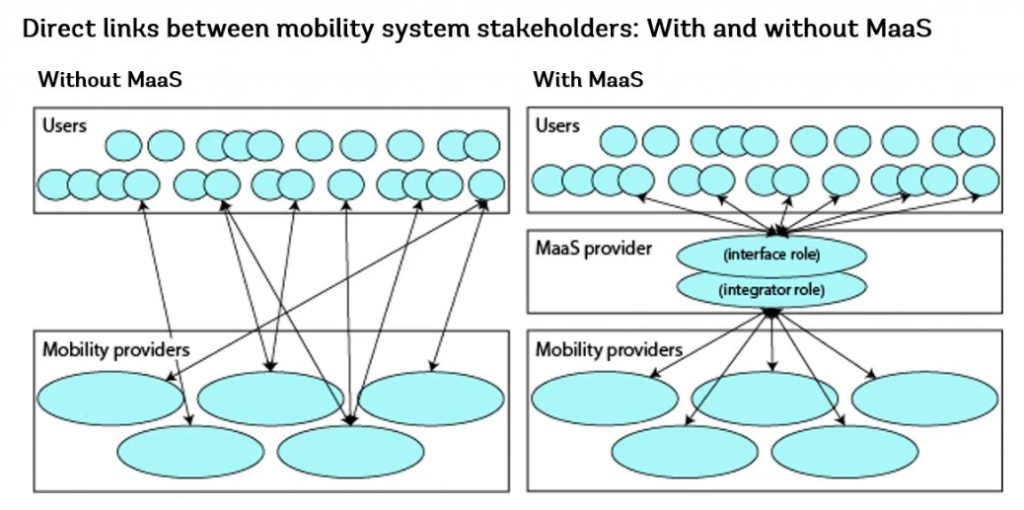Mobility-as-a-Service (MaaS) can help developing cities make the most of complex urban transport systems—if they implement it right

Residents in urban areas now enjoy an unprecedented array of mobility choices. Beyond conventional modes such as walking, biking, and traditional public transportation, a surge of modern, tech-driven services has emerged. These include ridesourcing, car-sharing, bike-sharing, and scooter-sharing, adding diversity to the urban transport scene. Notably, these services are gaining traction in low- and middle-income countries, contributing to an already intricate and partially organized transport system characterized by fragmented, undercapitalized, and underregulated private
While broadening travel options, the intricacies and disarray associated with this expansion often impose burdens on cities and their residents:
- From a city perspective, the lack of cohesion among various mobility services can lead to redundancies and counterproductive competition within the market, adversely affecting safety, comfort, and environmental and operational efficiency. Furthermore, these disorderly and uncoordinated urban transport markets tend to marginalize many users, particularly the poorest and most vulnerable.
- For commuters, selecting the optimal option often involves gathering and comparing (often incomplete) information from various sources, obtaining separate tickets or subscriptions for different segments of the journey, and more—all for a single trip. When travelers bear the full burden of planning, booking, paying for, and navigating multiple modes, it’s understandable that they gravitate towards private vehicles, which offer door-to-door service without the need for complex, multi-modal transfers—even when this choice comes at a high monetary and environmental cost.
Hence, developing cities necessitate a comprehensive organizing framework that facilitates the integration of diverse mobility options and orchestrates their collaboration. This approach aims to create a more streamlined travel experience and contribute to broader developmental objectives.
Various definitions of Mobility-as-a-Service (MaaS) exist, yet they commonly share the vision of challenging the necessity for ownership, be it of a car, motorcycle, or other modes of transportation. Instead, MaaS aims to empower users by allowing them to access the most optimal mode or modes of travel on a trip-by-trip basis.
This is accomplished through MaaS acting as a simplifying link between users and mobility services, typically facilitated by a technology-enabled platform, such as a smartphone app (refer to the Figure). MaaS serves as a unified interface where users can plan, book, and pay for a diverse array of mobility services, catering to any travel requirement. By doing so, the responsibility of integrating multimodal travel shifts from the traveler to the MaaS provider, effectively minimizing inefficiencies and additional costs associated with navigating a multitude of fragmented transport services.

This presents cities with a novel opportunity to plan comprehensive urban mobility systems rather than individually regulating each mobility service. To maximize the advantages, city governments must swiftly equip themselves to (1) comprehend the challenges and opportunities of integrating various modes in an increasingly data- and technology-driven mobility market and (2) establish a governance and regulatory framework that offers clear directives on how the transport system should evolve to support broader social, environmental, and economic objectives.
Achieving this necessitates the creation of an enabling environment by the public sector for information exchange, ensuring a level playing field for all modes and operators. A Mobility-as-a-Service (MaaS) governance model should be outcome- and goal-oriented, enabling policies like pricing and space allocation to be applicable across modes while incentivizing the adoption of the most efficient and sustainable options. This transformation requires the public sector to function as a facilitator, relying on the development of analytical capacity, flexibility to experiment with new models, and a willingness to reform the regulatory environment.
With strategic guidance from the public sector, the implementation of Mobility-as-a-Service (MaaS) has the potential to act as a catalyst in efforts to enhance inclusive access and bridge the digital divide, particularly in emerging economies. However, in the absence of government leadership, MaaS’s reliance on technology might exacerbate issues related to mobility and digital equity. Government intervention is therefore crucial in steering MaaS implementation towards achieving sustainable urban development goals, including improved access, social inclusion, and climate action.
For MaaS to have a meaningful and positive impact in developing cities, it must address the needs of all urban travelers, not just those belonging to higher-income brackets who currently use technology-enabled mobility services. The public sector can play a pivotal role in this by enacting policies and regulations that enhance the affordability of MaaS and expand its coverage. Additionally, while emerging economies may lag in deploying the digital and financial technologies that underpin MaaS, its implementation could leverage innovations from these markets, such as mobile payments and super apps, to help broaden access.
Source: WorldBank
